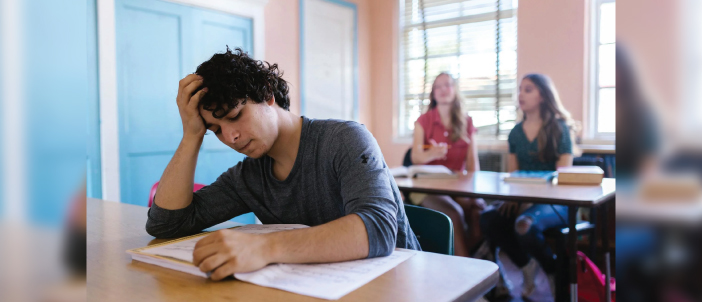Navigating Exams Amid Shrinking Attention Span :
A Psychologists’ Take
How shrinking attention spans and digital overload sabotage exam prep—and science-backed strategies to reclaim focus.

Two weeks before her board exams, 17-year-old Tina settled at her desk to revise science. Ping! A message from her friend Akshaya lit up her phone. Curious, she clicked: “another Instagram reel!”: One reel led to another, and soon Tina found herself in an endless scrolling of Instagram reels. Fifty minutes later, her textbooks lay untouched. “I hadn’t studied a word,” she admits, her voice tinged with frustration. Tina’s experience is far from unique - it’s emblematic of a generation battling what psychologists call the “attention span crisis.” A November 2023 study in Frontiers in Cognition reveals the severity: the average young adult’s attention span has dwindled to 76.24 seconds—barely over a minute—before they succumb to distraction.
The Vicious Cycle
The pressure of high-stakes exams heightens a student's stress levels, amplifying their brain’s vulnerability to distractions. To make matters worse, the distractions themselves can provoke more stress and self-doubt, particularly through social comparison on social mediaEndless streams of flawless snapshots and success stories can leave a student feeling outmatched and inferior. Motivation theories suggest that students who doubt their abilities (low self-efficacy) are more likely to procrastinate, as they feel less control over their learning and exam outcomes. Scrolling offers temporary relief from the fear of failure but ultimately worsens productivity, creating a self-feeding cycle of procrastination, self-doubt, panic, and plummeting productivity. And yet, most students struggle to resist the distraction, and scientists have explained this using neuroscience.
The Science of Attention
Neuroscience reveals that digital distractions - far from harmless breaks- actively rewire the brain. The human brain is naturally drawn to novelty and pleasure, a phenomenon popularly referred to as a “dopamine hit.” Often mistaken as the “pleasure chemical,” dopamine actually drives motivation and craving. Social media exploits this by offering unpredictable rewards—like random reels—just like slot machines. Each ping! triggers anticipation, reinforcing the habit and making the experience addictive. The problem is: our brains can only process a limited amount of information at once. The constant barrage of distractions weakens our ability to concentrate on tasks that require sustained cognitive effort, ultimately impairing the brain's capacity to absorb and retain study material. The relentless influx of information from smartphones, social media, and the internet fragments our attention, making it increasingly challenging to remain focused on a single task for an extended period. Frequent task-switching, coupled with stress, further overwhelms the brain, diminishing focus and making studying more difficult.
Breaking the Cycle
The good news? Attention spans can be trained, just like muscles. Good news is: attention spans can be trained and strengthened just like training a muscle or learning how to drive. Managing distractions, adopting effective study techniques and adopting a healthy mindset can significantly improve focus. With consistent effort, change is possible. Consistent efforts can make this happen. Attention spans vary with interest: students naturally focus better on subjects they find interesting. students are able to pay better attention in some classes than others. Creative techniques like colour-coded notes, funny fonts or repeating key statements in a funny voice, quirky mnemonics, mind mapping for revision can help to make study sessions more engaging. Digital distractions can be minimized with practical steps like using features of digital detox and well- being on devices, internet blockers, logging out of social media apps and deleting distracting apps (and using browsers instead). Scientists suggest that these steps work well especially for individuals who find it difficult to discipline themselves. Simply placing the phone face down on the study table isn’t always enough as its mere presence can diminish the ability to focus: keeping it entirely out of sight is often more effective. It is important to remember that nervousness is natural. We have all experienced that knot in the stomach. Simple relaxation techniques, such as box breathing (inhale for 4 seconds, hold for 4, exhale for 4) have been scientifically proven to help individuals stay calm. Anxiety often stems from also playing out the worst-case scenarios playing out in the mind - "What if I fail?" or "What if I forget everything?". De-catastrophizing involves challenging irrational fears by considering the worst, best, and most realistic outcomes to reduce anxiety and regain perspective. Reframing negative thoughts (e.g., “I’ll do my best” instead of “I can’t”) may also help. Grounding techniques work effectively in the face of panic attacks: identify 5 things you see, 4 things you touch, 3 things you hear, 2 things you smell, and 1 thing you taste. Students can also seek psycho-social counselling by calling the District Bureau of Employment and Enterprises (DBEE) helpline at 9915789068 or via the 24/7 Interactive Voice Response System (IVRS) helpline by CBSE at 1800-11-8004 from February 1 to April 4, 2025. In cases of extreme anxiety and unmanageable panic, calling helplines like Tele-MANAS at 14416 or 1-800-891-4416 or reporting to the nearest psychiatric emergency may be considered. To prevent mental fatigue, structured breaks are essential. Breaking tasks into manageable chunks (e.g., finishing a chapter before taking a break) or employing the Pomodoro technique (study for 25–30 minutes followed by a short break) can help avoid brain overload. Rather than avoiding distractions altogether, it is recommended to use them as rewards - for example, enjoy 20 minutes of chatting with friends after 40 minutes of studying. However, many students report difficulty in returning to task from the breaks. In this case, the two-minute rule - commit to a task for just two minutes can be helpful. In general, getting enough sleep, nutrition, and physical activity are crucial for maintaining focus and mental health. However, each individual's coping plan may be different. Identifying what works for each person is important. Students can consider making note of personal triggers that lead to distraction, such as boredom, and replacing them with meaningful activities like exercise (short walks or stretching), puzzles, or art can be helpful. Tailoring the study environment, whether preferring silence or a group setting, home or library, can also boost productivity. While technology isn’t inherently villainous, its unchecked use rewires brains ill-suited for deep work. The goal isn’t to eliminate distractions, but to build self-awareness. Teach students to notice when their focus drifts—and gently guide it back. That skill will outlast any exam. For Tina, small changes made a difference. She began stashing her phone in her mother’s room during study hours and using a star chart to track Pomodoro cycles. “It’s still hard,” she says, “but I feel more in control.” In an age of infinite scroll, the agency to pause, breathe, and refocus may be the ultimate edge.







